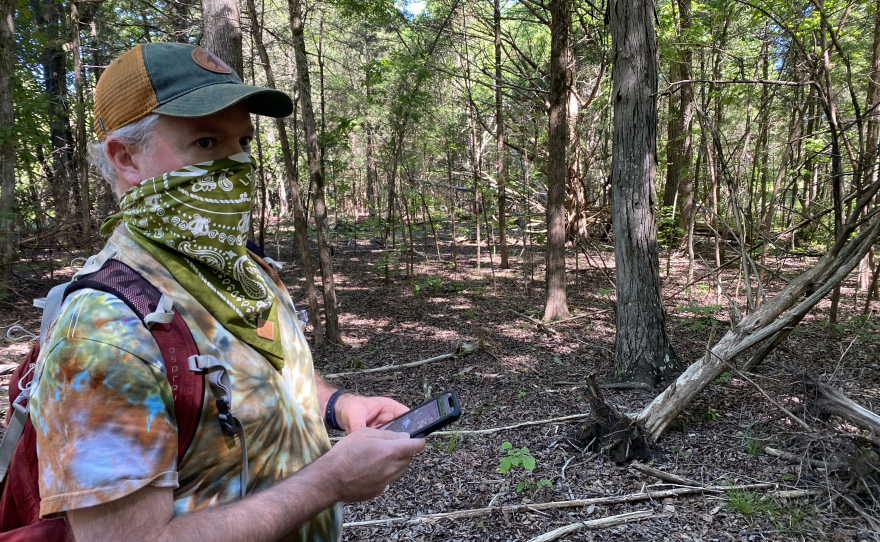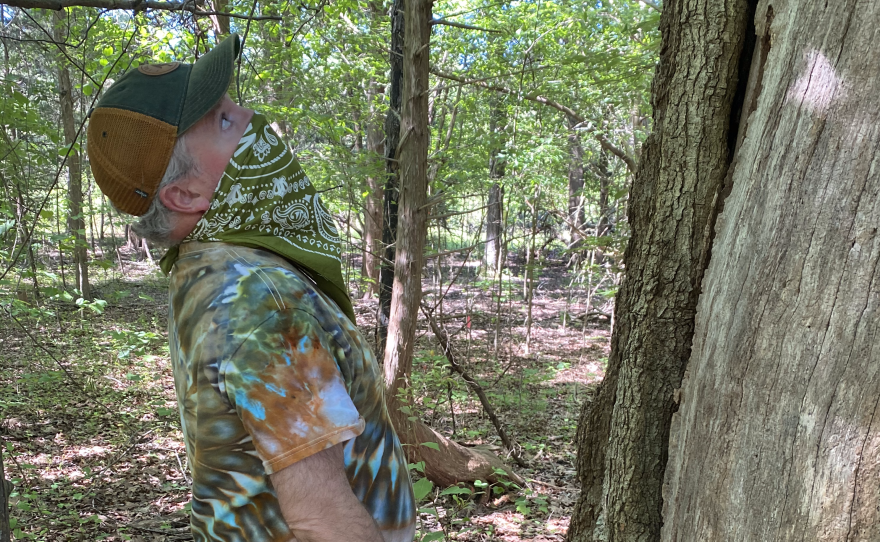Charlotte's rapid development in the past 20 years has threatened the city’s tree canopy, with at least 400 total acres lost since 2012. Among those lost are some of Charlotte’s biggest trees, and now there's an effort to track down a number of the city’s historic "treasure trees."
On a recent day, Brett Dupree was on the hunt in the McDowell Nature Preserve in southwest Charlotte.
His mission was to find an overcup oak. The species' name comes from its acorns, which have a "cup" that nearly encompasses them. The tree loves growing in wetlands, which makes it rare in Charlotte. He’s visited here three times in the past year and a half, but no luck.
“Alright, I think we want to go this way, yeah," Dupree said. Two miles in, we cut through the trail and continued along a road. The grass here was overgrown and we couldn't see where we were stepping.
“Garter snakes, brown snakes," Dupree noted. "There’s probably copperheads out here, so, you just have to be highly aware and alert and on your toes.”
And then the hard part: We both crouched down and walked more than a hundred yards, passing through brush that goes over our heads and trees with spindly branches that reach out for us like hands.
“Have you done a lot of bushwacking?" Dupree asked.
After an hour and half of hiking, we reached a bog. It was bigger than a football field, with trees growing all around still water. Dupree has approached this bog from all different sides before, trying to identify which tree is his Overcup Oak. And then:
"Oh my god," Dupree said. "You’re not going to believe this. We found it. Can you believe that? Oh my god. You’ve gotta be kidding me."

Sure enough, the overcup oak in front of us had a diamond-shaped tag hanging from a single nail on the trunk. The tag is weathered, colored green and white, a faint “17” stamped on it. It reads simply: “treasure tree.”
Dupree is part of a new effort to find Charlotte’s “treasure trees."
"Treasure trees" was a program started in the mid-1980s by Charlotte residents like Tom Martin and Joe McLaren. Its volunteers identified, documented and celebrated 123 of the largest and most significant trees in Mecklenburg county. But by 2000, people had moved on, and the program died out.
Dupree and other volunteers have been tracking down the original information about those trees. An IT professional by day, Dupree has become a self-taught “tree hunter” who spends his weekends exploring the greenways, parks and woods around Charlotte.
"My wife will tell you I’m a collector," Dupree said. "Having this list of 123 special trees, I really have fallen in love with trees in the past couple of years. So that kind of became a collection challenge, to go out there and find all these trees."
Dupree has taught himself to look at trees differently than most people. He points out a beech tree flanking a creek on one of the trails here.
An average person might notice how tall the tree is. When Brett Dupree saw this tree, he looked at how its roots have exposed themselves above the ground and are crawling toward the creek.

"This is really cool," Dupree said. "It’s actually growing into a creek bank. And it’s not actually growing in the creek, it’s just hanging onto the side of the bank. But it’s basically using this as a plumbing system, right? To feed this tree."
One of the people who’s grateful for Dupree’s work is a local tree expert named Patrick George, who calls himself the "benevolent dictator" of his company, Heartwood Tree Service.
George has lived in Charlotte since the 1960s. He said back then, walking around Charlotte was like walking in the woods. In the decades since, he’s seen neighborhoods like Dilworth and Myers Park lose many of their large, hundred-year-old trees to storm damage and residents cutting them down.
George was one of many people who have tried to recreate the treasure tree program in the past 20 years. His effort, called Jewels of the Crown, identifies some of Charlotte’s mature trees and gives them life-extending care. George said he’s also given tours to draw attention again to Charlotte’s best trees.
"People could get a look at these magnificent organisms that are parked in people’s backyard and front yards and parks and along creek banks now that are greenways that are easily accessible," George said.
George’s effort is being combined with Dupree’s work. They’re both part of a committee started in January 2018 at the Big Tree Summit, hosted by the advocacy group TreesCharlotte. It includes tree enthusiasts like Dupree and George, tree canopy officials with the city of Charlotte and TreesCharlotte. The committee is a revival and an expansion of the original idea of Treasure Trees: Treasure Trees version 2.0.
But first, the volunteers need to find all of the trees.
After more than two decades, some of them are hidden in places now overgrown. Some of them have incomplete data about their location. Others are probably gone. That’s why Dupree has taken up the call to find them.
Back at the bog, the overcup oak was in bad shape. It had easily been almost 110 feet back in the 1990s, now it reached only 65 feet. It was also missing its bark on one side. Dupree said it was likely struck by lightning. He believed insects had bored into the exposed trunk.
The tree was alive, but Dupree said its days were numbered. Still, he was happy he’s found it. He called it his “holy grail.”

As with every tree he finds, Dupree took photos and measured the tree’s height using a laser tool he held up like a looking glass. Then, he pinned a special measuring tape into the bark and wrapped it around the trunk. He estimated its circumference to be 10 feet, 10 inches.
Dupree and other volunteers have discovered about a third of the original 123 trees documented as treasures. Another third are confirmed to have died or been cut down. And the last third are still out there, waiting to be found.
Dupree will have to go on private property to look for those. Meanwhile, the committee is working on a website for the new program. They hope that by this summer, residents will be able to propose new candidates to become treasure trees.
"They are legacies to the environmental changes," Dupree said. "It’s just, it’s like a sentinel, it’s been standing there for 150 years, you know. And people live and die during all that time, and yet the tree outlives four or five generations of people, right?"
Dupree said this effort is bigger than finding individual trees. He came here to inspire people to care more about them, so that Charlotte residents four or five generations from now will have a greener, more vibrant city.
Heartwood Tree Service is a corporate sponsor of WFAE.







